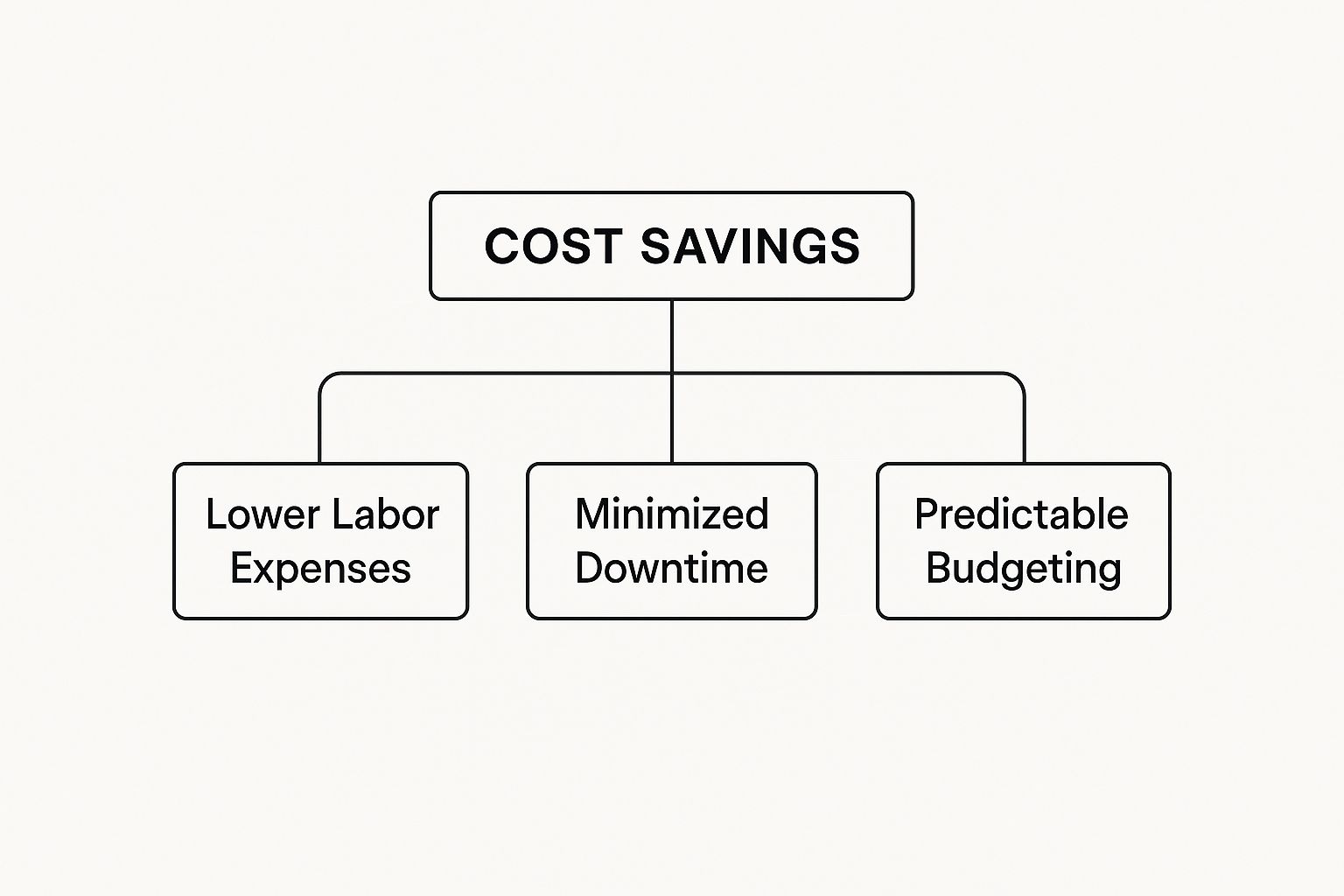Why Smart Businesses Are Ditching In-House IT Teams
Imagine it’s 3 AM during your busiest sales period, and your e-commerce site crashes. Your one IT specialist? Unreachable. This isn’t just a bad dream; it’s a real-world scenario that highlights a major risk for many UK businesses. The traditional in-house IT team, once seen as a symbol of a self-reliant company, can often become a strategic weakness.
The Expertise Gap and The Cost Conundrum
For many small to medium-sized businesses, relying on a single IT professional or a small team creates an instant knowledge gap. It’s simply not feasible for one person to master every specialism, from cybersecurity and cloud infrastructure to network management and day-to-day user support. This usually leads to a reactive “fire-fighting” mode, where problems are addressed only after they cause disruption, rather than being prevented in the first place.
On top of that, the true cost of an in-house team extends far beyond just salaries. When you factor in the additional expenses, the financial picture changes significantly. Think about the costs associated with:
- Continuous training and essential certifications
- Recruitment, onboarding, and retention efforts
- Providing cover for sick leave and holidays
- Subscriptions for specialised software and diagnostic tools
When you add up these hidden costs, the financial case for a dedicated internal team starts to look much less attractive. This economic reality, combined with the need for a wide range of skills, is driving a major shift in how businesses manage their technology.
A Growing Trend Towards Strategic Partnership
The move towards outsourced IT support is more than a simple cost-saving exercise; it’s a strategic choice to gain a competitive advantage. The UK market for IT support services has seen remarkable growth, which shows a fundamental change in business thinking. Industry analysis valued the sector at an estimated £29 to £31 billion in 2024, and it’s projected to climb to around £50 billion by 2025. You can explore more about the market dynamics and insights into the UK’s IT support sector. This growth points to one clear trend: businesses want access to high-level expertise without the heavy price tag.
The Wikipedia page on Information Technology Outsourcing outlines the global factors pushing this trend, such as cost benefits and access to a wider talent pool.

By partnering with an external provider, companies can draw on a collective of specialists. This ensures that problems are solved faster and more effectively, and that the business receives better strategic guidance than a small internal team could ever realistically offer.
Decoding The Three Flavours Of IT Support Partnership
Choosing the right outsourced IT support is a bit like picking a travel partner for your business journey. You might just need breakdown cover for a flat tyre, a reliable mechanic for regular servicing to keep the engine running smoothly, or a co-pilot who helps you map out the fastest, most scenic route to your destination. Each approach suits different business needs, budgets, and ambitions.
Understanding these models is the first step towards finding a partnership that genuinely fuels your company’s growth. Let’s look at the three main options.
Break-Fix: The Reactive “Pay-As-You-Go” Model
The most straightforward model is break-fix IT support. Think of this as the technology world’s equivalent of an emergency call-out service. When something goes wrong—a server crashes, a laptop refuses to connect to Wi-Fi, or essential software glitches—you call them. They come in, fix the immediate problem, and you pay for their time and any parts used. There’s no monthly contract, just a bill for each incident.
For businesses with very simple IT setups or extremely tight budgets, this can seem like a cost-effective choice. However, the biggest downside is that it’s entirely reactive. The provider only makes money when your systems fail, so there’s no real incentive for them to prevent problems. This can lead to more frequent and disruptive downtime, which often ends up costing far more in lost productivity than the repair bill itself. It’s a short-term patch, not a long-term solution.
Managed Services: The Proactive Partnership
This is where managed services change the game, shifting the focus from reacting to problems to actively preventing them. Instead of waiting for something to break, a managed service provider (MSP) works to stop issues from happening in the first place. For a predictable monthly fee, they monitor your systems 24/7, apply security updates, manage data backups, and perform routine maintenance. This proactive approach is now a standard expectation for many businesses.
To help you understand the different approaches, this table compares the key features of each IT support model.
| Model Type | Cost Structure | Response Time | Best For | Key Benefits |
|---|---|---|---|---|
| Break-Fix | Per-incident billing (hourly rate + parts) | Varies; often slower as there’s no SLA | Businesses with minimal IT needs and very low budgets. | Low upfront cost; pay only for services used. |
| Managed Services | Fixed monthly fee (subscription) | Guaranteed via Service Level Agreement (SLA) | SMEs wanting predictable costs and proactive maintenance. | Prevents downtime; predictable budgeting; enhanced security. |
| Strategic Partnership | Custom pricing (retainer or project-based) | Proactive and aligned with business schedule | Growth-focused businesses needing technology to drive strategy. | Aligns IT with business goals; long-term planning; competitive advantage. |
As you can see, moving from a break-fix model to managed services introduces predictability and proactive care, which are crucial for stability and growth.
This infographic shows how a proactive approach contributes to significant cost savings over time.

The financial benefits aren’t just from lower repair costs but from creating a stable, predictable budget and avoiding the high price of business interruption.
Strategic Partnership: Aligning Technology with Business Goals
The most advanced model is the strategic partnership, sometimes called a co-managed IT approach. This goes far beyond just keeping your systems online. A strategic partner acts as a virtual Chief Information Officer (vCIO), collaborating with your leadership team to ensure your technology directly supports your main business objectives.
They assist with long-term planning, create technology roadmaps, and help with budget forecasting, making sure every pound spent on IT drives growth and improves efficiency. This model is perfect for ambitious companies that see technology not just as a cost but as a vital tool for gaining a competitive edge. It’s the difference between having a mechanic on call and having an engineering strategist on your board.
The Hidden Forces Driving The Outsourcing Revolution

While predictable costs and proactive upkeep are certainly appealing, the real story behind the move to outsourced IT support is much more profound. It’s a story about ambition, managing risk, and keeping up with the constant march of technology. Many business leaders now see IT not as a simple utility like electricity or water, but as the engine for growth and a key competitive advantage. This strategic perspective uncovers the true motivations pushing businesses towards expert external partners.
The Ever-Growing Need for Specialised Expertise
Think about building a house with just a general handyman. They might be skilled at basic jobs, but you wouldn’t ask them to handle the complex electrical wiring or the structural engineering. Modern business technology is the same; it requires a team of specialists. A single, in-house IT generalist simply cannot be an expert in every critical area.
This is where outsourcing becomes a real game-changer. Businesses are choosing outsourced IT support to get instant access to a deep pool of talent in specific fields, such as:
- Advanced Cybersecurity: Protecting a business from sophisticated digital threats requires dedicated experts who are completely immersed in the world of security. This is a level of focus most small and medium-sized businesses can’t afford to maintain internally.
- Cloud Architecture: Getting the most out of cloud services for performance, security, and cost is a specialist skill. The right expertise can have a major positive impact on a company’s finances.
- Compliance and Data Governance: Finding your way through complex regulations like GDPR demands specific knowledge to avoid significant fines and damage to your reputation.
- Strategic Technology Planning: A good IT partner does more than fix problems; they help align technology spending with your core business goals, ensuring every pound invested supports growth.
A Strategic Shift in Business Operations
The trend towards outsourcing is so significant that it’s now a defining feature of business-to-business operations in the UK. Data for 2025 shows that 34% of B2B organisations now outsource their IT support, which makes it the most commonly outsourced business service in the country. You can learn more about the latest trends in UK business outsourcing to see how widespread this approach has become.
This statistic shows a key change in thinking: outsourcing is no longer just about cutting costs, but is a core strategy for achieving operational excellence. It allows businesses to create a more level playing field. A small company in Norfolk can access the same high calibre of IT expertise as a large corporation in London, helping it to compete on a much bigger stage. By entrusting technical management to a reliable partner, leaders can shift their focus from fixing IT issues to driving their business forward, knowing their technology is secure, efficient, and ready to grow with them.
The Real Math Behind IT Support Investment
Forget about vague promises of savings and marketing fluff for a moment; let’s discuss the actual numbers. Working out the cost of outsourced IT support is a bit like buying a reliable car. You don’t just focus on the monthly payment; you have to factor in fuel, insurance, maintenance, and its long-term reliability. The initial price tag rarely gives you the full picture, and the same applies to IT services.
Decoding Common Pricing Models
The cost of outsourced IT support can differ greatly depending on how it’s structured. Providers generally use a few common pricing models, and knowing how they work is essential for making a sound financial decision.
- Per-User/Per-Device Model: This is a predictable, easy-to-understand approach. You pay a set monthly fee for each employee or device that needs support. It makes budgeting simpler and scales up or down as your company grows or changes.
- Tiered Packages: Many providers offer various service levels (think Bronze, Silver, Gold), each with a growing list of services and support options. This structure allows you to select a package that fits your specific business needs and budget.
- Project-Based Fees: For specific, one-off tasks like an office move, a major software migration, or a complete network overhaul, you’ll typically pay a fixed price for the project. This is usually separate from your ongoing support agreement.
Looking Beyond the Obvious Expenses
A frequent mistake is to directly compare the monthly fee of an outsourced provider against the salary of an in-house IT employee. This comparison overlooks the significant hidden costs of an internal team, which include recruitment fees, ongoing training and certifications, and employee benefits. Another critical factor is the true financial impact of system downtime, which can cost some businesses thousands of pounds every hour. A proactive outsourced partner helps to minimise this risk, providing value that goes far beyond the monthly invoice.
To give you a clearer picture of the costs involved, here’s a breakdown of average IT outsourcing costs for UK businesses.
UK IT Outsourcing Cost Breakdown
Average costs for different types of outsourced IT services per employee and business size in the UK market
| Service Type | Small Business (1-50) | Medium Business (51-200) | Large Business (200+) | Industry Average |
|---|---|---|---|---|
| Basic IT Support (Helpdesk) | £30 – £50 /user/month | £25 – £45 /user/month | £20 – £40 /user/month | £35 /user/month |
| Managed IT Services (Proactive) | £60 – £100 /user/month | £50 – £90 /user/month | £45 – £80 /user/month | £70 /user/month |
| Cybersecurity Services | £20 – £40 /user/month | £18 – £35 /user/month | £15 – £30 /user/month | £28 /user/month |
| Fully Outsourced IT Department | £120 – £200 /user/month | £100 – £180 /user/month | £90 – £150 /user/month | £140 /user/month |
This table shows that while per-user costs often decrease with scale, the investment remains significant. The figures highlight the importance of choosing a plan that aligns with both your team’s size and your operational needs, from basic helpdesk support to comprehensive, fully managed services.
The investment UK businesses are making in this area is substantial. The average spend per employee in the UK IT outsourcing market is forecast to reach approximately £980 in 2025. This signals a growing understanding that smart IT investment isn’t just an expense—it’s a vital component for business resilience and growth. You can explore the full UK IT outsourcing market projections to see these trends for yourself. Calculating the genuine return on your investment means looking at the total cost of ownership and appreciating how expert support can prevent expensive disruptions.
What Modern IT Support Actually Delivers
The old picture of IT support—a technician reluctantly asking, “have you tried turning it off and on again?”—is completely out of date. Today, a genuine outsourced IT support partnership delivers a wide range of services that go far beyond simple troubleshooting. Think of it less like a repair service and more like having a dedicated technology department focused on pushing your business forward. This modern approach mixes day-to-day assistance with high-level strategic guidance to build a resilient and efficient operational foundation.

The Wikipedia entry on managed services shows the main idea: a proactive delivery model where the provider takes on responsibility from the client, guided by a clear Service Level Agreement. This agreement formalises the relationship, making sure the provider is accountable for results, not just for fixing problems as they happen.
Core Services: The Non-Negotiables
At the centre of any worthwhile partnership are the fundamental services that keep your business running smoothly and securely. These should be seen as standard, not as premium extras. If a provider doesn’t excel in these areas, they aren’t a serious contender.
These core services typically include:
- Proactive Network Monitoring: This is 24/7 surveillance of your systems to spot and fix issues before they can cause downtime. It’s the difference between preventing a fire and having to put one out.
- Responsive Help Desk Support: Quick and effective help for your team when they face technical problems. This ensures productivity isn’t stopped by small glitches. Many of the most common IT support problems can be sorted out fast with expert remote assistance.
- Robust Cybersecurity: This is more than just antivirus software. It includes managing software updates, configuring firewalls, and training employees on security to guard against a growing number of threats.
- Data Backup and Disaster Recovery: This service ensures your critical business data is regularly backed up and can be quickly restored after a system failure, cyberattack, or natural disaster.
Advanced Capabilities: Fuelling Growth and Resilience
Beyond the basics, forward-thinking providers offer advanced services that can give you a real competitive edge. These services show a partner’s ability to think strategically about your business. A solid modern IT support setup will focus on comprehensive IT service continuity management, making sure systems stay operational and can withstand disruptions.
Other advanced services might include:
- Cloud Optimisation: Managing and improving your cloud setup for better performance, security, and cost-effectiveness.
- Compliance Management: Helping your business follow industry-specific rules like GDPR, which protects you from potentially large fines.
- Strategic Technology Planning: Acting as a virtual Chief Information Officer (vCIO) to help you create a technology plan that fits your long-term business goals and budget.
When you’re looking at potential providers, it’s vital to ask detailed questions about what they offer in both core and advanced areas. This will help you see any gaps in your current setup and find a partner that can truly support your journey to growth.
Finding Your Perfect IT Support Match
Choosing an outsourced IT support provider is less like hiring a contractor and more like selecting a new business partner. This decision directly influences your daily productivity, the trust your customers have in you, and your ability to keep operating during a crisis. The process has to go beyond simply comparing prices and ticking off features on a list. To find the right fit, you need to dig into their technical skill, cultural alignment, and the fine print of how they deliver their service.
A truly professional provider becomes an extension of your own team, so their approach and values must resonate with your business culture. If expectations don’t align, it can lead to friction and poor service, no matter how technically skilled the provider is.
Evaluating Technical Expertise and Industry Knowledge
The first step is to assess their real-world capabilities. Don’t just accept a list of certifications at face value; ask for case studies or references from businesses similar to yours, especially within your industry. A provider with experience in retail, for example, will understand the critical importance of keeping point-of-sale systems online, a detail a generalist might overlook. This industry-specific knowledge is invaluable because it means they can anticipate your unique challenges rather than just reacting to them.
When looking at potential partners, ask specific questions about their team’s experience:
- How do you ensure your technicians stay up-to-date with emerging security threats?
- Can you describe a complex problem you solved for another client in our sector?
- What is your process for documenting our specific network and software setup?
The quality of their answers will reveal far more about their expertise than any marketing brochure ever could.
Understanding Service Level Agreements (SLAs)
The Service Level Agreement (SLA) is the backbone of your partnership. This legally binding document details the provider’s commitments on service quality, response times, and system availability. It is one of the most important documents to review carefully.
Here is an example showing the key components often found in an SLA.

This structure shows that a proper SLA defines everything from the scope of services to performance metrics and penalties for not meeting those standards. A vague or poorly defined SLA is a major red flag. It should clearly state guaranteed response times for different levels of issue severity and map out the escalation procedure if a problem isn’t fixed promptly.
If a provider seems hesitant to commit to firm metrics in an SLA, it could suggest a lack of confidence in their own ability to deliver. You can explore more tips on how to pick the best IT support service for your business in our detailed guide. This careful evaluation ensures your chosen partner is not just another supplier, but a reliable ally committed to your success.
Making Your IT Partnership Actually Work
Signing on the dotted line is just the first step. The real effort begins when you transform that new outsourced IT support agreement into a genuine, working partnership. Like any strong business relationship, it depends on clear communication, mutual accountability, and having the same goals in mind. Just handing over the keys without laying a proper foundation can lead to frustration and disappointment. A well-managed partnership, on the other hand, becomes a true asset for your business.
Establishing Clear Communication and Accountability
The initial onboarding phase is absolutely vital. This is your chance to set the ground rules with your new provider. A frequent error is to depend on informal chats or emails, which often results in lost requests and delayed responses. The most successful partnerships are built on a more structured approach.
Imagine you’re building a house: you wouldn’t start laying bricks without a detailed blueprint. Your partnership’s blueprint should cover:
- Defined Communication Channels: Decide on the main points of contact and the right channels for different situations. For instance, use a ticketing system for everyday requests and a dedicated phone number for urgent problems.
- Regular Review Meetings: Plan for monthly or quarterly catch-ups. These meetings are for reviewing performance against the Service Level Agreement (SLA), discussing solved issues, and planning for future technology needs. This keeps everyone on the same page and accountable.
- A Clear Escalation Path: What’s the plan if a major issue isn’t being resolved fast enough? Having a documented escalation procedure means you know exactly who to contact next, which helps avoid panic and confusion when things go wrong.
Managing Transitions and Measuring Success
Whether you’re moving from an in-house team or switching providers, the transition needs careful handling to keep your business running smoothly. A professional IT partner will walk you through a structured process that includes moving data, communicating changes to staff, and making sure there is no downtime for your essential systems.
Once everything is up and running, how do you know if the partnership is truly valuable? Success isn’t just about the absence of problems; it’s about making positive strides forward. You should consistently track Key Performance Indicators (KPIs), looking at figures like the average time it takes to resolve a ticket, system uptime percentages, and feedback from your users. This data-focused method helps you have meaningful conversations about service quality and ensures your investment in outsourced IT support provides real, measurable benefits over time.
At Ibertech Solutions, we focus on building partnerships that are designed for growth, not just basic maintenance. If you’re ready for an IT relationship that truly supports your Norfolk or Suffolk business, contact us today to explore how we can help you reach your goals.





